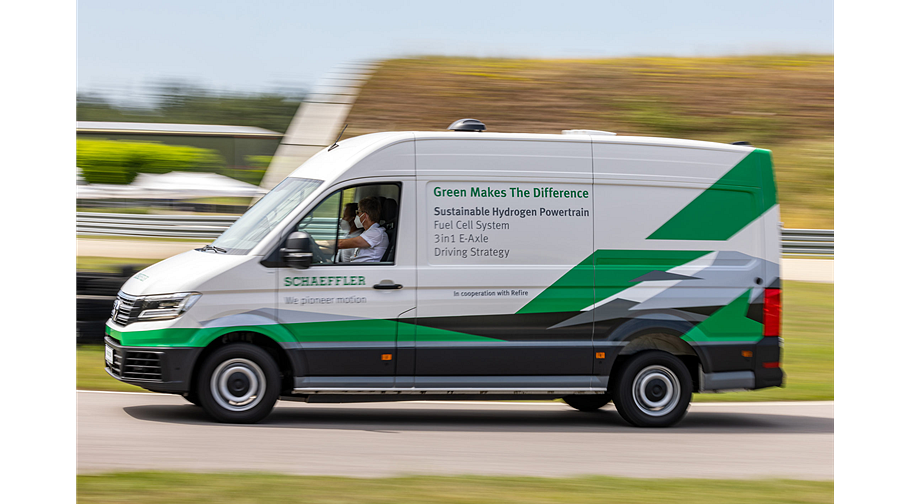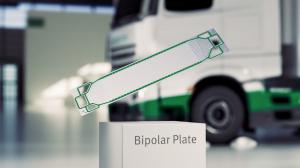
- Fuel cell-powered demonstrations vehicle showcased in cooperation with REFIRE.
- Schaeffler develops key components and systems for hydrogen mobility.
- Innoplate joint venture to take bipolar plates into large-scale production.
 ARLANDASTAD, SWEDEN – Schaeffler’s focus on drive systems for commercial vehicles includes hydrogen technology, especially for long-haul applications. The company is developing innovative components for fuel cell systems and laying the groundwork for them to be produced on an industrial scale. “Schaeffler sees fuel cells as an important part of the overall mix of drive technologies for commercial vehicles,” says Mathias Lindgren, Head of Automotive, Schaeffler Nordic. To this end, Schaeffler has collaborated with REFIRE, a leading global supplier of commercial hydrogen fuel cell technologies. The vehicle is driven by a 3in1 e-axle powered by a fuel cell system. Its electric axle, fuel cell stack, control system, and energy management system were all designed and built by the e-mobility experts at Schaeffler. Schaeffler presented the vehicle at IAA transportation earlier this autumn, as an example of optimal interoperability between electric drive, fuel cell, and lithium-ion battery technology. “Initially, fuel cell drives will be used mainly in long-haul commercial vehicles. Vans will benefit from this technology too because they regularly also cover longer distances,” Lindgren explains.
ARLANDASTAD, SWEDEN – Schaeffler’s focus on drive systems for commercial vehicles includes hydrogen technology, especially for long-haul applications. The company is developing innovative components for fuel cell systems and laying the groundwork for them to be produced on an industrial scale. “Schaeffler sees fuel cells as an important part of the overall mix of drive technologies for commercial vehicles,” says Mathias Lindgren, Head of Automotive, Schaeffler Nordic. To this end, Schaeffler has collaborated with REFIRE, a leading global supplier of commercial hydrogen fuel cell technologies. The vehicle is driven by a 3in1 e-axle powered by a fuel cell system. Its electric axle, fuel cell stack, control system, and energy management system were all designed and built by the e-mobility experts at Schaeffler. Schaeffler presented the vehicle at IAA transportation earlier this autumn, as an example of optimal interoperability between electric drive, fuel cell, and lithium-ion battery technology. “Initially, fuel cell drives will be used mainly in long-haul commercial vehicles. Vans will benefit from this technology too because they regularly also cover longer distances,” Lindgren explains.
Efficient industrialization of components for fuel cell systems
The various components and systems that make up fuel cells include bipolar plates. “We are using our high-precision forming and stamping technology and innovative surface coating processes to make ultra-efficient, high-performance bipolar plates,” Lindgren continues. For Schaeffler, developing processes such as forming and coating for extremely thin steel parts like bipolar plates has largely been a case of adapting processes that it has already been using for many years in the manufacture of motor and transmission components.
Schaeffler is also leveraging its bearings know-how to develop various axial and radial air foil bearings. In addition, the company is continually growing its expertise and capabilities in fuel cell system control, including software modules for fuel cell-specific functions.
Demonstration vehicle highlights Schaeffler’s systems expertise
In all aspects of its fuel cell development and optimization work, Schaeffler maintains an uncompromising focus on producing components and subsystems that work together efficiently as integrated systems. Its hydrogen experts have built a complete fuel cell system specifically for mobile applications and have incorporated it into a demonstration vehicle. The vehicle was unveiled to the public for the first time at the IAA Transportation show earlier this autumn. It features a 13 kWh battery with a maximum power output of 85 kW, and a fuel cell system rated for a continuous output of 50 kW. Propulsion is provided by a Schaeffler 3in1 e-axle, complete with power electronics, with a maximum output of 140 kW. Schaeffler is using the vehicle as a development platform for testing and optimizing the interaction between the various system components.
Joint venture for large-scale production of bipolar plates
The key to achieving widespread use of fuel cell powertrains is to manufacture the components and subsystems at scale so as to make them as cost-effective as possible. This focus on industrialization is a core part of Schaeffler’s strategy. By partnering with Symbio, a hydrogen technology joint venture between Forvia and Michelin, to establish Innoplate, Schaeffler aims to transition its bipolar plates into industrial production at the start of 2024. The partners in the Innoplate joint venture intend to produce plates for both mobile and stationary applications. The joint production facility will be located in Haguenau, France, and will initially have an annual output of four million plates, increasing to approximately 50 million by 2030. “The objective of the joint production operation between Schaeffler and Symbio is to achieve major economies of scale, which are essential in order to produce stacks cost-effectively,” says Erik Askensjö, CEO Schaeffler Nordic.
Read the most up to date Fuel Cell and Hydrogen Industry news at FuelCellsWorks
The Nordic countries invest in renewable energy
According to Energinyheter.se (1), the Nordic countries are well prepared and ready to invest in renewable energy that can be used to create Hydrogen. In the past years, the Nordic countries have built up a strong knowledge base and developed a common understanding about the topic. Through a specific R&D program, a strategic cooperation around hydrogen has been developed. The program’s purpose is to increase research and development efforts around hydrogen and other alternative fuels, over the next few years. The interest in being part of this program from companies’ and institutions’ sides is big (2). “It is positive that the process of delivering renewable energy is speeding up, and Schaeffler is also well prepared. Renewable energy – especially hydrogen – has a lot of benefits for our environment. And Schaeffler has all the prerequisites for becoming a strong player in the field of environmentally friendly hydrogen-powered vehicles,.” ends Askensjö.




